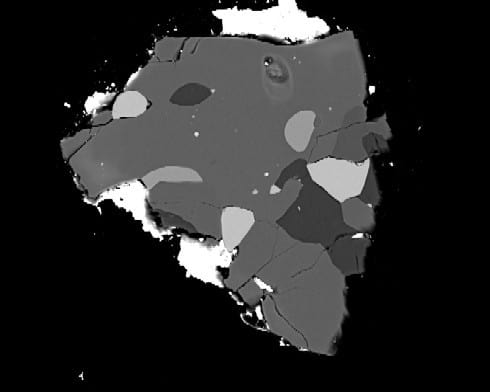
A single particle from the Itokawa asteroid. Courtesy: Science/AAAS
By Tushna Commissariat
When you think about near-Earth asteroids, they mostly bring to mind discussions about how to blow them up or move them out of the way, if they are headed towards us, perhaps with an afterthought of Bruce Willis. It is rather strange to think of engineering a method to ‘capture’ a neighbouring asteroid into an Earth-bound orbit. But that is exactly what a recent paper published on the arXiv pre-print server is looking at.
The researchers, from Tsinghua University in Beijing, China, have proposed coaxing a near-Earth object (NEO) into a “temporary capture”, such that it becomes a satellite of the Earth. A likely candidate for this type of acquisition would be an NEO with a low-energy orbit that can be captured by Earth with a slight increase in the asteroid’s velocity. The authors point out that some Jovian comets are routinely claimed by Jupiter, orbiting around the gas giant from one to several orbits, which would be a period of a few Earth years.
Unfortunately, this is not something that will occur with the Earth and any of its NEOs naturally. But some NEOs will be tauntingly close to Earth’s orbit and would require just a gentle nudge in the right direction. In the paper, the researchers consider the necessary conditions to artificially engineer this. They look at the mechanics of a three-body problem – the Sun, the Earth and the asteroid – and calculate at which orbital co-ordinates the capture would be successful and how much of a change in orbit and velocity, with respect to the NEO in question, would be required.
Using these parameters, they then listed possible candidates from the known NEOs. A candidate that caught their eye is a 10 m NEO that will pass within a million kilometres or so of Earth in 2049. Its orbital velocity is close enough to that of the Earth that it could be captured into an Earth-bound orbit by a velocity change of only 410 mps. This would allow it to orbit Earth at nearly twice the distance of the Moon, before it wanders off like Jupiter’s comets.
But what is the point of it, you ask? As the researchers themselves point out, “a 2 km-size metallic NEO, for example, may contain rich metals and materials worth more than 25 trillion dollars”. While the concept of mining an asteroid had been around for a while, a practical method has not been found. The recently returned Hayabusa mission from the Itokawa asteroid was delayed by three years and its final sample was of about 1000 particles of asteroid dust – more than enough for research but not exactly a bountiful harvest in terms of minerals (see image above). Having an asteroid “on a leash” would make it a lot easier to study and mine them.



